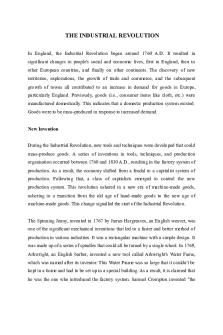Copy of Chapter 9 Industrial Revolution Study Guide PDF

| Title | Copy of Chapter 9 Industrial Revolution Study Guide |
|---|---|
| Course | World Cities |
| Institution | University of Toledo |
| Pages | 4 |
| File Size | 68.9 KB |
| File Type | |
| Total Views | 137 |
Summary
study guide...
Description
Chapter 9: Industrial Revolution Study Guide
Be able to define what is the Industrial Revolution. -
The industrial revolution started in the 18th and 19th century
-
The process of change from an agrarian and handicraft economy to one dominated by industry and machine
Identify the three factors of production. -
Land, labor, and capital
Be able to define the policy of laissez-faire. -
The economic policy of letting owners industry and business set working conditions without inference
Know the definition of a “union”. -
Asn act or instance of uniting or joining
How all the Agricultural Revolution lead to the Industrial Revolution. -
New farming techniques and improved livestock breeding led to amplified food production
Know what impact the steam engine had on Britain.
-
The use of steam-powered machines in cotton productions pushed Britain’s economic development from 1750 to 1850. This would cause the first industrial revolution
Be able to identify how the Industrial revolution affected cities. -
Changed materials production, wealth, labor patterns, and population distribution
Know what impact did technological advances have on the industry. -
Technological advances increased the supply and demand, employment rate skyrocketed.
-
Improved quality and size of production and Increase profits, generated other industrial improvements and reduces their price and increase in goods
Know the positive and negative aspects of industrialization. -
Made work cheaper, employed a thousand workers, and improved people’s daily lives,
-
The exploitation of workers, overpopulation in urban cities, and environmental damages
Know what the long-term effects of Marx and Engels The Communist Manifesto? -
The proletarians of movements centered around the concept of proletariat
-
Written by Karl Marx in 1848 argued that all societies have always been divided into one class. The abolition of private property, and the lack of need for government would secured peace and progress
Capitalism is this type of economic model.
-
A mixed economy
Socialism is this type of economic model. -
Command economy
Be able to define “strike”. -
a refusal to work organized by a body of employees as a form of protest, typically in an attempt to gain a concession or concessions from their employer.
Be able to define “lockout”. -
the exclusion of employees by their employer from their place of work until certain terms are agreed to.
Know what Wilbur Wilberforce did as a member of Parliament -
Wanted slavery abolished .
Extended Response Questions
What made 18th-century Great Britain ideal for rapid and revolutionary industrialization? -
Access to raw materials, trade routes and partners, social changes, and a stable government
Why might the philosophy of communism have appealed to many 19th-century factory workers? -
Communism appealed to them because it would better their own lifestyles
Do you think the concept of complete reliance on a free-market system, using 19th-century Britain as a model, worked well? Explain. They did not have government control, which they believed was a wonderful concept, but they did not have very high pay for the employees. They had risky employment, and many youngsters were compelled to work. The disabled had difficulty finding work. -
What are the risks of going on strike? What are the potential rewards if a strike is successful, what are the consequences? -
Striking imposes cost on the employees the employers and the entire economy may suffer loss when they are during strike...
Similar Free PDFs

Industrial Revolution
- 2 Pages

Study Guide Chapter 9
- 2 Pages

Industrial Revolution
- 19 Pages

Chapter 9 Study Guide
- 5 Pages

Chapter 9 Study Guide
- 17 Pages

Study Guide Chapter 9
- 1 Pages

Copy of Final Study Guide
- 64 Pages

THE Industrial Revolution
- 4 Pages

Industrial Revolution in Canada
- 5 Pages

Industrial Psychology Study Guide
- 17 Pages
Popular Institutions
- Tinajero National High School - Annex
- Politeknik Caltex Riau
- Yokohama City University
- SGT University
- University of Al-Qadisiyah
- Divine Word College of Vigan
- Techniek College Rotterdam
- Universidade de Santiago
- Universiti Teknologi MARA Cawangan Johor Kampus Pasir Gudang
- Poltekkes Kemenkes Yogyakarta
- Baguio City National High School
- Colegio san marcos
- preparatoria uno
- Centro de Bachillerato Tecnológico Industrial y de Servicios No. 107
- Dalian Maritime University
- Quang Trung Secondary School
- Colegio Tecnológico en Informática
- Corporación Regional de Educación Superior
- Grupo CEDVA
- Dar Al Uloom University
- Centro de Estudios Preuniversitarios de la Universidad Nacional de Ingeniería
- 上智大学
- Aakash International School, Nuna Majara
- San Felipe Neri Catholic School
- Kang Chiao International School - New Taipei City
- Misamis Occidental National High School
- Institución Educativa Escuela Normal Juan Ladrilleros
- Kolehiyo ng Pantukan
- Batanes State College
- Instituto Continental
- Sekolah Menengah Kejuruan Kesehatan Kaltara (Tarakan)
- Colegio de La Inmaculada Concepcion - Cebu





